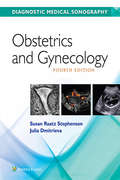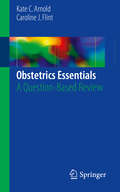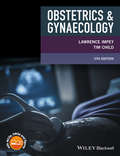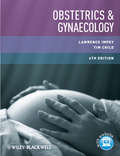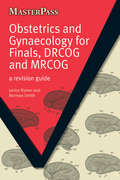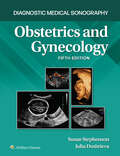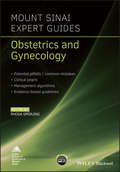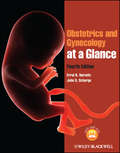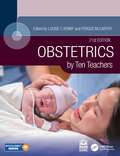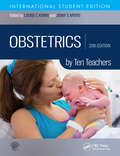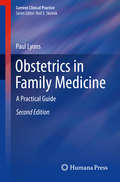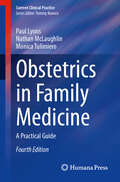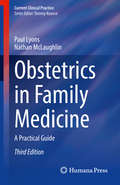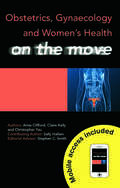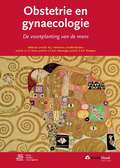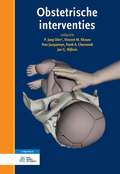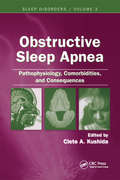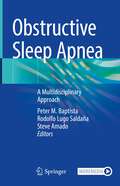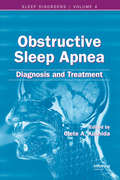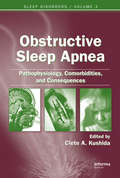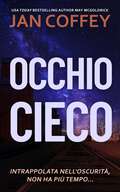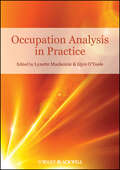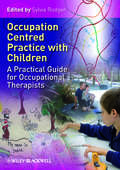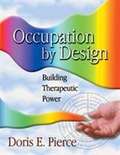- Table View
- List View
Obstetrics & Gynecology: A Guide To Clinical Practice, Obstetrics And Gynecology (Diagnostic Medical Sonography Series)
by Susan Stephenson Julia DmitrievaThe updated Diagnostic Medical Sonography Series, which includes new editions of Diagnostic Medical Sonography: Abdomen and Superficial Structures, Diagnostic Medical Sonography: Obstetrics and Gynecology, and Diagnostic Medical Sonography: The Vascular System, provides the right content at the right level for the right way to teach and learn. The updated 4th Edition of Stephenson’s Diagnostic Medical Sonography: Obstetrics and Gynecology offers the most in-depth, current, and consistent coverage of this crucial sonography topic available today.
Obstetrics Essentials
by Kate C. Arnold Caroline J. FlintThis book is a compact question-based review of the most critical topics an obstetrician will come across in practice. Each chapter includes 10-30 multiple-choice questions designed to test the readers understanding surrounding one obstetric topic. Based on all 45 obstetric based practice bulletins by ACOG, this text is designed to keep practitioners up-to-date with the latest evidence based medicine. Sample topics include: anemia in pregnancy, screening for fetal chromosomal abnormalities, and vaginal birth after previous cesarean delivery. This is an ideal tool for attendings and clerkship directors who frequently test residents and medical students during rounds and in the classroom. This review also proves useful for practicing physicians and physicians-in-training who want to self-evaluate their comprehension and study for board examinations.
Obstetrics and Gynaecology
by Lawrence Impey Tim ChildObstetrics & Gynaecology has established itself as a key recommendation for faculty and a firm favourite for health sciences students.The opening sections of this new edition incorporate the relevant basic science, history and examination, investigations and diagnosis, as well as common diseases, abnormalities, and complications in gynaecology and obstetrics respectively. These are supported by two unique sections on gynaecology and obstetrics management, which are tailored to help students revise for exams, especially OSCEs. A brand new chapter covering ethics in obstetrics and gynaecology makes this fully-updated fourth edition the most comprehensive introduction available.Obstetrics & Gynaecology now includes a companion website at www.impeyobgyn.com, featuring self-assessment MCQs and EMQs, chapter summary slides, and all the figures from the book as PowerPoint slides.
Obstetrics and Gynaecology (Oxford Medical Handbooks Ser.)
by Lawrence Impey Tim ChildObstetrics & Gynaecology has established itself as a key recommendation for faculty and a firm favourite for health sciences students. The opening sections of this new edition incorporate the relevant basic science, history and examination, investigations and diagnosis, as well as common diseases, abnormalities, and complications in gynaecology and obstetrics respectively. These are supported by two unique sections on gynaecology and obstetrics management, which are tailored to help students revise for exams, especially OSCEs. A brand new chapter covering ethics in obstetrics and gynaecology makes this fully-updated fourth edition the most comprehensive introduction available. Obstetrics & Gynaecology now includes a companion website at www.impeyobgyn.com, featuring self-assessment MCQs and EMQs, chapter summary slides, and all the figures from the book as PowerPoint slides.
Obstetrics and Gynaecology for Finals, DRCOG and MRCOG: A Revision Guide (MasterPass)
by Norman Smith Janice RymerThis examination and revision guide comprehensively tests knowledge at all levels in obstetrics and gynaecology. The wide-ranging sample questions have detailed answers to provide proper explanation and aid understanding, and the variety of question formats prepares students for all possibilities in the examination. The best of five question format is ideal for DRCOG candidates, the EMQs prepare the MRCOG candidates, and the MCQs will test both DRCOG and MRCOG candidates. The book is also highly recommended for undergraduates preparing for their finals, who will welcome the sample best of fives and EMQs now that essays and short answer questions are becoming a thing of the past.
Obstetrics and Gynecology (Diagnostic Medical Sonography Series)
by Susan Stephenson Julia DmitrievaPart of the highly regarded Diagnostic Medical Sonography series, Susan Raatz Stephenson and Julia Dmitrieva’s Obstetrics and Gynecology, 5th Edition, thoroughly covers the core content students need to master in today’s rigorous sonography programs. Careful, collaborative editing ensures consistency across all three titles in this series: The Vascular System, Abdomen and Superficial Structures, and Obstetrics and Gynecology, providing the right content at the right level for both students and instructors.
Obstetrics and Gynecology (Mount Sinai Expert Guides)
by Rhoda SperlingMount Sinai Expert Guides: Obstetrics and Gynecology provides specialty trainees and junior physicians with an extremely clinical, affordable and accessible handbook covering the key and hot topics in this complex field with focus throughout on clinical diagnosis and effective patient management. Used as a point-of-care resource in the hospital and clinical setting, it present sthe very best in expert information in an attractive, quick and easy to navigate informative and well-structured manner, with features such as key points, potential pitfalls, management algorithms, and national/international guidelines on treatment.
Obstetrics and Gynecology at a Glance
by Errol R. Norwitz John O. SchorgeThis comprehensively updated new edition provides a thorough and dynamically-illustrated overview of the female reproductive organs, care of the female during pregnancy, childbirth and the postnatal period. It is clinically relevant, with a focus on diagnosing, managing and treating disorders and abnormalities and is fully aligned with medical school curricula.Obstetrics and Gynecology at a Glance:* Recaps basic history taking, anatomy and endocrinology and focuses on clinically relevant information* Covers each topic in a double-page spread, packed with charts, graphs, photographs and visuals* Includes thoroughly updated sections on reproductive endocrinology, infertility and urogynecologyThe companion website at www.ataglanceseries.com/obgyn features interactive flashcards, case studies and multiple-choice questions (MCQs).Obstetrics and Gynecology at a Glance is the perfect guide for medical students, junior doctors and midwives, and is ideal for those embarking on clinical rotations and the clerkship.
Obstetrics and Gynecology in Low-Resource Settings
by Nawal M. NourObstetrics and Gynecology in Low-Resource Settings provides practical guidelines for ensuring quality care to women in locations where facilities are inadequate, equipment and medications are in short supply, and medical staff are few. This reference will be an essential companion to health care providers throughout the world.
Obstetrics by Ten Teachers
by Louise C Kenny Fergus McCarthyFirst published in 1917 as 'Midwifery', Obstetrics by Ten Teachers is well established as a concise, yet comprehensive, guide within its field. The 21st Edition has been thoroughly updated by its latest team of 'teachers', integrating clinical material with the latest scientific developments that underpin patient care.Each chapter is highly structured, with learning objectives, definitions, aetiology, clinical features, investigations, treatments and key point summaries and additional reading where appropriate. A key theme for this edition is 'professionalism' and information specific to this is threaded throughout the text.KEY FEATURES* Fully revised – content is entirely refreshed and up to date for this twentieth edition, including the latest imaging and reproductive technologies and current guidelines for best practice Highly illustrated – text supported and enhanced throughout by high-quality colour line diagrams and photographs Clear and accessible – numerous features supplement the narrative text and provide useful queues for revision Illustrative case histories – engage the reader with realistic scenarios that bring obstetric practice to life Digital support material – download and personalise the ebook for fully-flexible access and visit [www.routledge.com/cw/mccarthy] for additional resources including questions for self-assessment, video and patient interviews Along with its companion Gynaecology by Ten Teachers, 21st Edition, the books continue to provide an accessible 'one stop shop' in obstetrics and gynaecology for a new generation of doctors.The editors:Louise C Kenny is Professor and Executive Pro-Vice Chancellor of the Faculty of Health and Life Sciences at the University of Liverpool, UK.Fergus McCarthy is Senior Lecturer, University College Cork and Consultant Obstetrician & Gynaecologist and Maternal Fetal Medicine Subspecialist, Cork University Maternity Hospital, Cork, Ireland.
Obstetrics by Ten Teachers (20th Edition)
by Louise C. Kenny Jenny E. MyersFirst published in 1917 as 'Midwifery', Obstetrics by Ten Teachers is well established as a concise, yet comprehensive, guide within its field. The twentieth edition has been thoroughly updated by a new team of 'teachers', integrating clinical material with the latest scientific developments that underpin patient care. Each chapter is highly structured, with learning objectives, definitions, aetiology, clinical features, investigations, treatments, case histories and key point summaries and additional reading where appropriate. New themes for this edition include 'professionalism' and 'global health' and information specific to both areas is threaded throughout the text. Along with its companion Gynaecology by Ten Teachers the book will continue to provide an accessible 'one stop shop' in obstetrics and gynaecology for a new generation of doctors.
Obstetrics in Family Medicine
by Paul LyonsThis book surveys the normal obstetrics encountered in primary care and serves as a practical guide to the evaluation and management of common prenatal, peripartum and postpartum complications. Thoroughly revised and updated, Obstetrics in Family Medicine, Second Edition, addresses the major issues and problems related to each stage and outlines management protocols. It provides critical information about physical and ultrasound examinations, laboratory tests, drug toxicities, and screening techniques and highlights new and emerging areas of obstetrical care, such as prenatal testing protocols, treatment options for HIV in pregnancy and antenatal monitoring. Key points for each topic are summarized in tabular form for quick reference and diagnostic flow charts illuminate all aspects of the decision-making process. Concise and clinically oriented, this book is designed to help primary and family medicine physicians improve the quality of women's health care.
Obstetrics in Family Medicine: A Practical Guide (Current Clinical Practice)
by Paul Lyons Nathan McLaughlin Monica TulimieroObstetrics, as with all domains of medicine, is always advancing. New science leads to new practice while changes in the environment produce new and emerging challenges, such as the corona virus. The purpose of this new edition is to align this text and its state-of-the-art information with important changes that have occurred in the four years since the last edition was published. The first section of this book focuses on preconception and prenatal care. There are several crucial updates to these chapters. The most critical update to this section falls in the Vaccines in Pregnancy chapter and details the risks and benefits of the COVID vaccine in pregnant women and women looking to get pregnant. There are also counseling updates on preconception nutrition, preconception risk assessment, pre-existing disease management and advances in prenatal screening and prenatal US recommendations and infectious disease detection. Multiple updates on medications in pregnancy are also included as new classes of medications are frequent in this demographic such as diabetes and weight loss medications. The second section details various complications that arise in pregnancy. There are updates to the majority of the chapters in this section, some of which include new screening protocols for dysmorphic growth and genetics, treatments that have since been removed from preterm labor recommendations and again, the most major update would be to the infection in pregnancy chapter, particularly in terms of COVID. The smallest section of the book is the third one on labor and delivery. There are only three chapters in this section so there are minimal updates, but all current best practices are reflected. The fourth and fifth sections of this book focuses on complications of labor and delivery and postpartum management. There are both major and minor changes to these sections. A current understanding of what constitutes &“prolonged&” labor and best practice pathways are introduced as well as updates to the newborn evaluation including screening for genetic, cardiac and hearing issues as well as current guidelines for the management of hyperbilirubinemia. Written by experts in the field, this fully revised and expanded fourth edition of Obstetrics in Family Medicine is a valuable resource for a wide range of primary care providers who provide direct or indirect care of patients of childbearing age. This book also appeals to nurse practitioners, physician assistants and nursing personnel working in the primary care setting. Additionally, this book serves as a useful guide for medical providers who intersect with pregnant, or possibly pregnant patients including emergency medicine physicians, surgeons, EMT's and paramedics.
Obstetrics in Family Medicine: A Practical Guide (Current Clinical Practice)
by Paul Lyons Nathan McLaughlinObstetrical care in the family medicine setting is an ever-evolving discipline. In addition to routine updates due to the passage of time, several new developments have occurred in the field since the last edition of this book was published. Among these developments are advances in prenatal assessment and diagnosis, recommendations for vaccination in pregnancy, assessment and management of infectious disease in pregnancy, and management of chronic disease concurrent with pregnancy. All thirty-one chapters of the second edition of this text have been thoroughly updated. Several chapters warranted substantive expansion and revision due to the developments on the topic. These chapters include preconception counseling, prenatal care, dysmorphic growth, preterm labor, recurrent pregnancy loss, infection, diabetes, postdates, normal labor, induction and augmentation, prolonged labor, fetal heart rate monitoring, routine postpartum and complications postpartum. A new chapter has been added that covers vaccination in pregnancy as well as other routine wellness recommendations. Now in its fully revised and expanded third edition, Obstetrics in Family Medicine reflects the significant changes that have occurred in the field since 2015. This book remains the definitive resource for meeting the needs of a wide range of primary care providers who provide direct or indirect care of patients of childbearing age. This book also appeals to nurse practitioners, physician assistants and nursing personnel working in the primary care setting. Additionally, this book serves as a useful guide for medical providers who intersect with pregnant, or possibly pregnant patients including emergency medicine physicians, surgeons, EMT's and paramedics.
Obstetrics, Gynaecology and Women's Health on the Move (Medicine on the Move)
by Amie Clifford Claire Kelly Chris Yau Sally HallamFirst Prize, BMA Medical Book Awards 2013The Medicine on the Move series provides fully flexible access to subjects across the curriculum in a unique combination of print and mobile formats ideal for the busy medical student and junior doctor. No matter what your learning style, whether you are studying a subject for the first time or revisiting it
Obstetrie en gynaecologie: De voortplanting van de mens
by M. J. Heineman J.L.H. Evers L.F.A.G. Massuger E.A.P. SteegersHet leerboek Obstetrie en gynaecologie. De voortplanting van de mens is een modern standaardwerk. De didactische opbouw, heldere stijl en de hoogwaardige illustraties maken het tot een onovertroffen leerboek. Elk hoofdstuk begint met leerdoelen en definities en wordt afgesloten met een samenvatting en een blik op de toekomst. Historie, methodologische aspecten, epidemiologie en demografie hebben een eigen plaats in de tekst, die is onderverdeeld in leer- en leesstukken. In kaders worden samenvattingen aangeboden. Casussen brengen theorie en praktijk bij elkaar. De referenties omvatten zowel klassieke en recente literatuur als vele internetadressen. in deze nieuwe, zevende druk is niet alleen de informatie geactualiseerd, maar zijn ook enkele nieuwe hoofdstukken (De jonge zwangerschap en Pre-maligne aandoeningen) toegevoegd. Daarnaast zijn er prachtige nieuwe illustraties opgenomen die eerder werden gepubliceerd in het boek Obstetrische interventies. En dat is niet alles: er is ook een begin gemaakt met een aan dit leerboek gekoppelde elektronische leeromgeving waar aanvullende informatie gevonden kan worden. Kijk voor verdere verdieping op de website StudieCloud.Het leerboek Obstetrie en gynaecologie heeft een lange geschiedenis. In 1973 verscheen, onder leiding van prof. dr. G.J. Kloosterman, De voortplanting van de mens, het voornaamste leerboek voor obstetrie en gynaecologie van de jaren zeventig en tachtig van de vorige eeuw. Het boek kwam tot stand door een goede samenwerking tussen de Nederlandstalige universiteitsklinieken en was uniek omdat voor het eerst in één leerboek alle onderdelen van de obstetrie en gynaecologie een plaats kregen. In 1993 nam prof. dr. P.J. Treffers het hoofdredacteurschap over en beleefde het boek, waarvan de titel was gewijzigd in Obstetrie en gynaecologie, twee drukken. Vanaf de derde druk is de uitgave herzien onder leiding van prof. dr. M.J. Heineman samen met nieuwe en jonge auteurs, allen werkend in vooraanstaande opleidingsklinieken, aan het bestaande schrijverscollectief toegevoegd waarmee de actualiteit van het leerboek gegarandeerd wordt.Inmiddels werken ruim zeventig specialisten, vrijwel allen actief in de zorg, mee aan dit boek. Daarmee wordt een volledig beeld gekregen van de obstetrie, gynaecologie en voortplantingsgeneeskunde en beschikken wij opnieuw over een compleet en overzichtelijk standaard
Obstetrische interventies
by Joep P. Dörr Vincent M. Khouw Yves Jacquemyn Frank A. Chervenak Jan G. NijhuisIn dit leerboek worden op heldere en indringende wijze de anatomie van het geboortekanaal, de mechanismen van de normale baring en de uitvoering van obstetrische interventies, zoals kunstverlossingen en keizersneden in het ziekenhuis, weergegeven. Maar ook problemen die in de eerste lijn kunnen voorkomen, bijvoorbeeld schouderdystocie, worden uitvoerig behandeld. 'Obstetrische interventies' is bedoeld voor studenten verloskunde en geneeskunde, artsen (in opleiding), tropenartsen, (klinisch) verloskundigen en gynaecologen. Met de bijdragen van ruim dertig auteurs uit Nederland, Vlaanderen en de Verenigde Staten wordt in dit boek inzicht gegeven in de keuzes die artsen en verloskundigen vóór, tijdens en na bevallingen elke dag en nacht weer moeten maken. De keuzes zijn zo veel mogelijk evidence-based. Via StudieCloud is met een code het boek ook online beschikbaar en kunnen de tientallen animaties bekeken worden.
Obstructive Sleep Apnea (Sleep Disorders)
by Clete A. KushidaResponding to the growing recognition of Obstructive Sleep Apnea (OSA) as a major medical condition and the emergence of exciting new therapies, this 2 volume source examines clinical features, characteristics, comorbidities, and impact of OSA on patient biological systems. Not to mention, diagnosis and treatment methods that include first-line and
Obstructive Sleep Apnea: A Multidisciplinary Approach
by Peter M. Baptista Rodolfo Lugo Saldaña Steve AmadoThe book provides a comprehensive overview of the medical implications, pathophysiology, and treatment of Obstructive Sleep Apnea (OSA), a disease that creates increased health risks, most notably those related to the cardiovascular and cerebrovascular systems.The opening chapters are dedicated to the definition of OSA, its diagnosis, and the treatment options. The following chapters address primary forms of disease presentation in each medical field, with the latest evidence.Given its characteristics, the book will enable the reader to adopt a broad strategy for evaluating and managing OSA patients. In addition, it will be a valuable resource for all the clinicians who treat sleep-disordered breathing, including otolaryngologists, pulmonologists, cardiologists, neurologists, etc.
Obstructive Sleep Apnea: Diagnosis and Treatment (Sleep Disorders)
by Clete A. KushidaMore than 18 million Americans have Obstructive Sleep Apnea (OSA), but more than 90% of cases still remain undiagnosed. This source offers a thorough review of key considerations in the identification and treatment of OSA, and discusses issues often unaddressed in other publications on the topic, such as gender, age, drug interactions, and associat
Obstructive Sleep Apnea: Pathophysiology, Comorbidities, and Consequences (Sleep Disorders)
by Clete A. KushidaResponding to the growing recognition of Obstructive Sleep Apnea (OSA) as a major medical condition and the emergence of exciting new therapies, this source analyzes the clinical features, characteristics, comorbidities, and impact of OSA on patient biological systems and quality-of-life. Edited by the Director of the Center for Human Sleep Researc
Occhio Cieco
by Jan Coffey May McGoldrickINTRAPPOLATA NELL'OSCURITÀ, NON HA PIÙ TEMPO... CONTO ALLA ROVESCIA PER IL DISASTRO DI CHERNOBYL... L'OROLOGIO INIZIA ORA. Tick… La scienziata Marion Kagan è l'unica sopravvissuta all'attacco armato contro la struttura segreta dove il suo team stava lavorando a un progetto top-secret. Ferita e intrappolata sotto le macerie, sa che deve impedire a ogni costo che campioni radioattivi sfuggano al controllo. Se fallisce, milioni di vite saranno in pericolo. …tick… A migliaia di chilometri di distanza, in un ospedale psichiatrico del Connecticut, la sorella gemella di Marion – in coma da anni – si agita improvvisamente nel suo letto. Qualcosa è cambiato. I medici decidono di utilizzare su di lei un programma sperimentale per "leggere" le immagini nella sua mente. Quello che scoprono va oltre ogni spiegazione scientifica… e li sconvolge. …tick… Un ex soldato americano, appena tornato dall'Iraq e alla ricerca di uno scopo, accende distrattamente il telegiornale. La notizia dell'esplosione nella struttura di ricerca passa quasi inosservata… finché non si rende conto che il destino gli ha appena assegnato una nuova missione. Una missione che lo trascinerà in un pericoloso gioco di intrighi internazionali e cospirazioni aziendali. …tick… Con il tempo che scorre inesorabile, tre vite si intrecciano in una corsa disperata contro il disastro. Legate da misteri scientifici, legami psichici e scelte fatali, Marion, sua sorella e il soldato si trovano al centro di una minaccia che potrebbe cambiare per sempre il destino dell'umanità. Il tempo stringe. Il conto alla rovescia è iniziato. Cosa dicono i lettori: "Questo libro mi è piaciuto molto. Jan Coffey ha costruito una trama complessa e assolutamente credibile. Grande attenzione ai dettagli scientifici e umani. Prima di iniziare, assicuratevi di avere tempo: non riuscirete più a smettere di leggere!" ★★★★★ "Ho scoperto Jan Coffey dopo aver lasciato l'esercito negli anni '90. Ogni suo romanzo è meglio del precedente. Suspense pura, scrittura impeccabile." ★★★★★
Occupation Analysis in Practice
by Lynette Mackenzie Gjyn O'TooleOccupation Analysis in Practice is the essential book for all future and current occupational therapists. It offers a practical approach to the analysis of occupations in real world practice.The book frames occupation as the key component for analysis and builds upon previous work limited to analysis at the activity level. It examines the interests, goals, abilities and contexts of individuals, groups, institutions and communities, along with the demands of the occupation. It presents examples of occupation analysis in different practice context including working with children, health promotion, indigenous health, medico-legal practice; mental health and occupational rehabilitation.The book has four sections. Section 1 introduces theoretical perspectives of the concept of occupation analysis and how such analysis relates to particular models of Occupational Therapy practice and the generic World Health Organisation International Classification of Functioning, Disability and Health. Section 2 discusses analysis of particular components of occupation that support practice. These include culture, spirituality, home and community environments as well as self-care and leisure. Section 3 applies analysis of occupations to particular specialties encountered in practice. Section 4 considers the application of Occupation Analysis within professional reasoning and goal setting.FEATURESInternational team of contributorsExamples of occupation analysis proformaApplication to a wide range of practice areas.Glossary of key termsIncudes the International Classification of Functioning, Disability and Health.
Occupation Centred Practice with Children
by Sylvia RodgerThis book draws on contemporary occupational therapy theory and research to provide occupational therapy students and clinicians with a practical resource on implementing occupation centred practice with children.Each chapter has specific objectives and uses case studies to demonstrate the clinical realities and applications of each of the topics addressed. Best practice guidelines are provided along with a summary of recommendations drawn from the relevant theories, occupational therapy philosophy and existing research. The book aims specifically to be practice based.
Occupation by Design: Building Therapeutic Power
by Doris PierceBecoming a Designer of Therapeutically Powerful Occupations, Designing for Appeal: Productivity, Pleasure, and Restoration in Occupations, Designing for Intactness: The Spatial, Temporal, and Sociocultural Dimensions, Designing for Accuracy: Elements of the Occupational Design Process, Conclusion.
